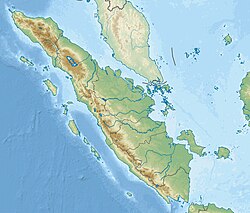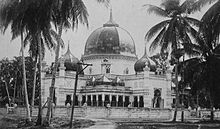| Azizi Mosque | |
|---|---|
Masjid Azizi | |
 | |
| Religion | |
| Affiliation | Islam |
| Ecclesiastical or organizational status | Mosque |
| Status | Active |
| Location | |
| Location | Tanjung Pura, North Sumatra |
| Country | Indonesia |
Location of the mosque in Sumatra | |
| Geographic coordinates | 3°53′29″N98°25′26″E / 3.891526°N 98.423973°E |
| Architecture | |
| Type | Mosque architecture |
| Style | Eclectic Mughal |
| Groundbreaking | 1899 |
| Completed | 1902 |
| Construction cost | 200,000 ringgit |
| Specifications | |
| Direction of façade | East |
| Capacity | 2,000 worshipers |
| Length | 25 m (82 ft) |
| Width | 25 m (82 ft) |
| Height (max) | 30 m (98 ft) |
| Dome(s) | 21; 4 main domes |
| Dome height (outer) | 20 m (66 ft) |
| Minaret(s) | 1 |
| Minaret height | 60 m (200 ft) |
| Site area | 3 ha (7.4 acres) |
| [1] | |
The Azizi Mosque is a mosque located in Tanjung Pura, in the Langkat Regency of North Sumatra, Indonesia. It was the royal mosque of the Sultanate of Langkat.

